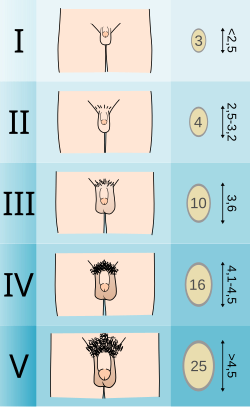Puberty
Puberty is a hormonally regulated process when sexual maturity and reproductive ability is developed, i.e., ovulation in girls and spermatogenesis in boys. Puberty is a physiological process and one of the functions of the reproductive hypothalamus-pituitary-gonad axis.[1]
Physiological Regulation of Puberty[edit | edit source]
The reproductive axis is already active in the fetal period (maximally in the 20th week of pregnancy) and in the infancy period ("physiological minipuberty") between the 3rd and 4th month of life). After minipuberty, activity of the reproductive axis decreases (negative feedback, central inhibition) and remains low throughout the childhood until the beginning of puberty. The beginning of puberty is controlled by the neurosecretion of gonadotropin releasing hormone (GnRH) from the hypothalamus. Both genetic factors and nutritional status (leptin level) influence the activation. Mature adrenal glands (adrenarche – 1–2 years before gonadarche) – the zona reticularis is activated and DHEA (dehydroepiandrosterone) secretion increases: adrenal androgens affect the development of pubic and axillary hair, acne, and body odor. The secretion of gonadotropins increases, the gonads mature (gonadarche), the production of sex hormones (estradiol, testosterone) increases, and the external and internal genitalia and secondary sex characteristics develop.
- In short:
- Hypothalamus: Gonadotropin-releasing hormone (GnRH) → anterior pituitary (adenohypophysis): gonadotropins (FSH, LH) → gonads (gonadarche): sex hormones (estradiol/testosterone) → development of external and internal genitalia, secondary sexual characteristics (thelarche, distribution of subcutaneous fat, etc...).
- Anterior pituitary (adenohypophysis): ACTH → adrenal gland (adrenarche): androgens (DHEA, DHEAS) → development of pubic hair (pubarche), axillary hair development, acne, body odor.
Assessment of Sexual Development[edit | edit source]
Tanner scale (1–5):
- development of pubic hair ("P"), or axillary hair ("A")
- breast development in females ("M")
- genital development in males ("G") + testicular volume increase (can be evaluated using a Prader orchidometer) (adult male: 17–30 mL)
- 1 = prepubertal stage
- 4 or 5 = adult stage[1]
Adolescence in Females[edit | edit source]
- Thelarche (development of breast): between 8–1 years of age (average: 10.5 years) – sign of gonadarche
- pubarche (beginning of pubic hair development) usually manifests 6 months after thelarche, but sometimes can be manifest earlier than thelarche; sign of adrenarche
- the growth rate increases, peaks around 12 years of age, the volume of the ovaries and uterus increases, the proportions between the cervix and the body of uterus change
- menarche: on average occurs at 13 years of age (about a year after reaching the maximum growth rate).[1]
Adolescence in Male[edit | edit source]
- Gonadarche (increase of testicular volume): between 9–14 years of age (average: 11,5 years of age); beginning of puberty = testicular volume 4 ml
- pubic hair grows soon after the gonadarche
- the highest growth rate is between 13 and 14 years of age (between G3 and G4)
- first ejaculation on average at 14 years of age
- dysphonia puberum (voice mutation) around the age of 14
- beards start to grow after the age of 15
- physiological epiphyseal closure (growth plate fusion) occurs soon after[1]
| Overview of Development in Puberty | ||
|---|---|---|
| Female | Male | |
| Onset of Puberty (gonadarche) |
8–13 years old (average: 10,5 years old) thelarche (breast development) |
9–14 years old (average: 11,5 years old) gonadarche (testicles 4 mL) |
| Highest Growth Rate | around 12 years old | 13–14 years old |
| Sexual Maturity | menarche: 13 years old (average) | first ejaculation: 14 years old (average) |
Trends in Adolescence[edit | edit source]
There is a gradual increase in body height in economically developed countries with earlier onset of puberty. The growth rate in the pre-adolescent period is increasing as well. The reason for this increased growth rate is due to the well-fed condition of children and higher level of hygiene. Speed of reaching full sexual maturity, however, has not changed.[1]
Links[edit | edit source]
Related Articles[edit | edit source]
- Adolescence
- Pubertas praecox • Pubertas tarda • Sexual development disorders
- Development of urogenital system • Endocrine diseases of the gonads • Psychophysiology of human sexuality • Disorders of sexual identity
Reference[edit | edit source]
- ↑ Jump up to: a b c d e LEBL, J – JANDA, J – POHUNEK, P, et al. Klinická pediatrie. 1. edition. Galén, 2012. 698 pp. pp. 173-180. ISBN 978-80-7262-772-1.




